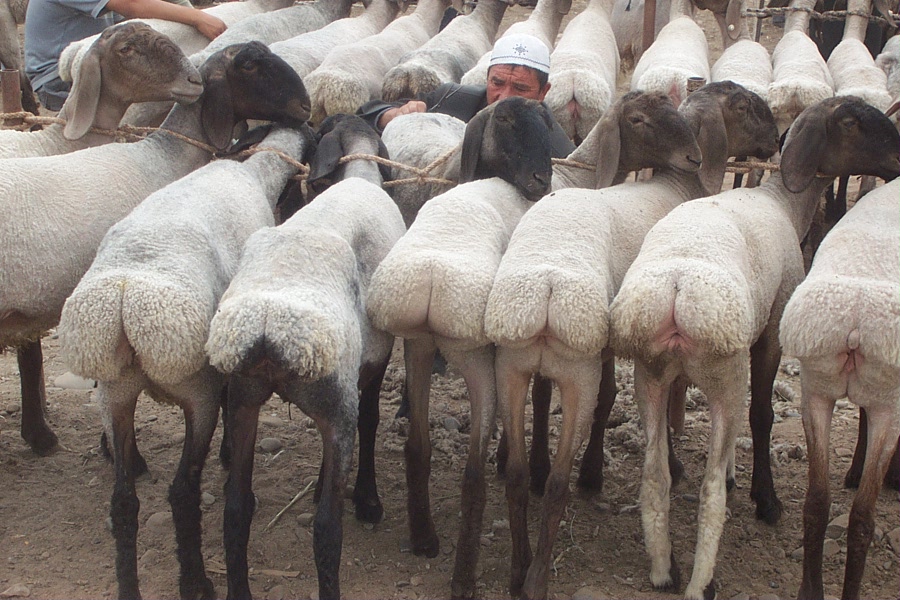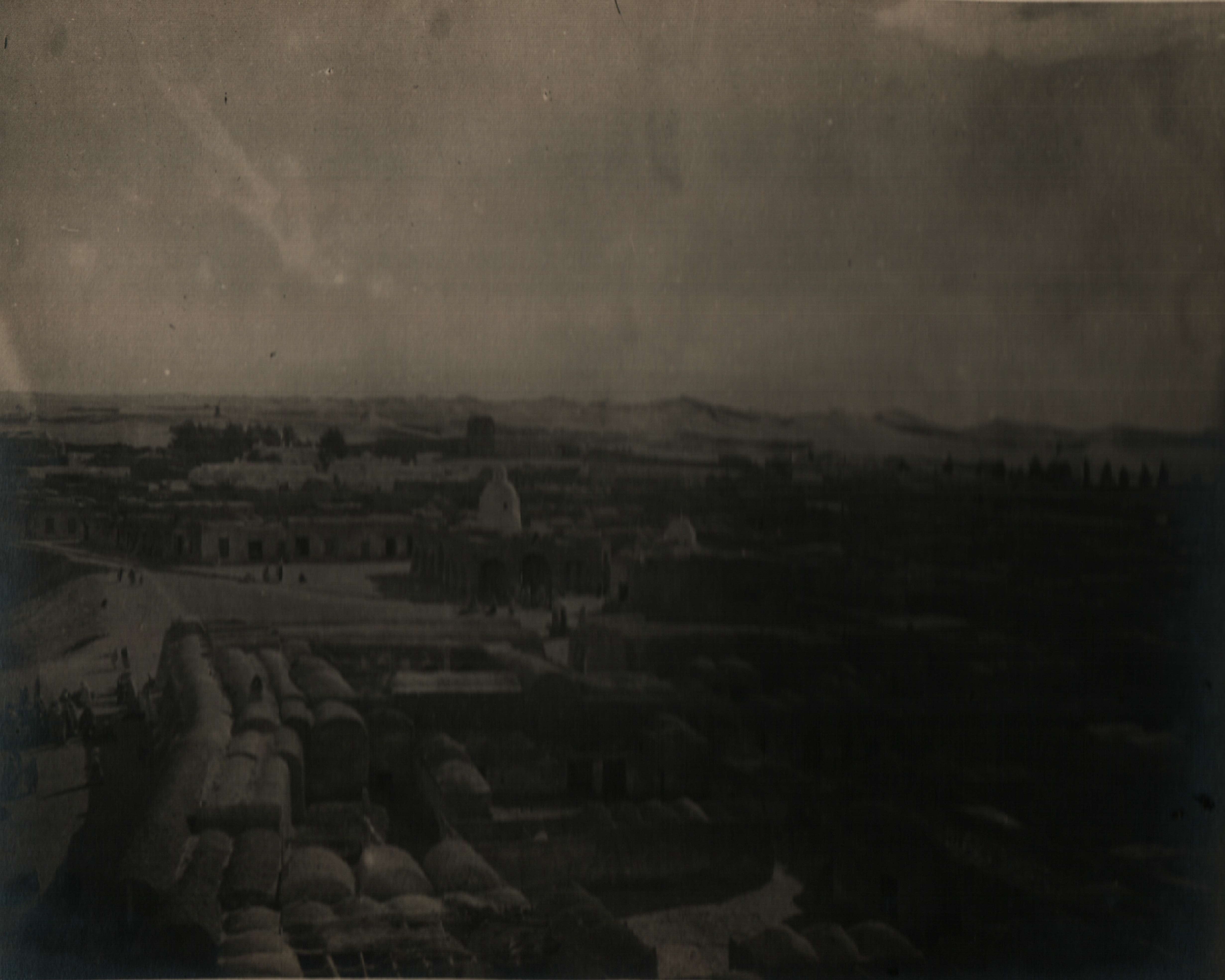|
Tunisian Barbarin
The Tunisian Barbarin is a Tunisian List of sheep breeds, breed of fat-tailed sheep. It is distributed throughout Tunisia, and on both sides of the Tunisian border with Algeria, on the Algerian side particularly in the area of Oued Souf. Related to the Awassi History The Tunisian Barbarin descends from the Near East Fat-tailed. Two Italian breeds, the Barbaresca Siciliana of Sicily and the Laticauda sheep, Laticauda of Calabria and Campania, are derived from it. In 1991 the total population in Tunisia was reported to be 5 million; in 1992, a population of 50 000 was reported in Algeria. In 2008, the Barbarin constituted about 60% of the overall sheep population in Tunisia, which was estimated to count approximately 4 million ewes. Characteristics The Barbarin is a coarse-wool breed, and is reared mainly for meat. It is particularly well adapted to the intense heat of desert areas, and can tolerate brackish water. The coat is white, and the face is either brick-red or b ... [...More Info...] [...Related Items...] OR: [Wikipedia] [Google] [Baidu] |
List Of Sheep Breeds
This is a list of breeds of domestic sheep. Domestic sheep (''Ovis aries'') are partially derived from mouflon (''Ovis gmelini'') stock, and have diverged sufficiently to be considered a different species. Domestic sheep breeds Sorted alphabetically. A B C D E F G H I J K L M N O P Q R S T U V W X Y Z Notes See also * List of cattle breeds * List of domestic pig breeds * List of goat breeds * Lists of domestic animal breeds References Sources * * * * * * * * * * * * * * * * * * * * * * * * * * * * * * * * * * * * * * * * * * * * * * * * * * * * * * * * * * * * * * * * * * * * * * * * * * * * * * * * * * * * * * * * * * * * * * * * * * * * * * * * * * * * * * * * * * * * * * * * * * External links Breeds of Livestock - Sheep BreedsDepartment of Animal Science - Oklahoma State University {{Breed Sheep breeds, List of Lists of breeds, Sheep ... [...More Info...] [...Related Items...] OR: [Wikipedia] [Google] [Baidu] |
Fat-tailed Sheep
The fat-tailed sheep is a general type of domestic sheep known for their distinctive large tails and hindquarters. Fat-tailed sheep breeds comprise approximately 25% of the world's sheep population, and are commonly found in northern parts of Africa, the Middle East, and various Central Asian countries all the way to China. The tail fat from those sheep is an important ingredient in many regional cuisines. Varieties and distribution Two general varieties of fat-tails exist, the broad fat-tails and the long fat-tails. The long-tailed varieties have the smallest geographical distribution, being found mostly in Arabia (a variety called the Nejd, black with a white head, named for the Nejd region, and raised also in Iraq, Central Asia, and Syria) and in the Caucasus (the Colchian, for the Colchis territory, and the Circassian). Broad varieties include the Hajaz (Arabia, small and white, named for the Hejaz region), the Arabi (black or piebald, in Arabia and Iraq), the Awassi (the ... [...More Info...] [...Related Items...] OR: [Wikipedia] [Google] [Baidu] |
Oued Souf
El Oued ( ar, اﻟﻮادي, ber, Suf meaning ''the River''), Souf or Oued Souf is a city, and the capital of El Oued Province, in Algeria. The oasis town is watered by an underground river, hence its name is El Oued which enables date palm cultivation and the rare use (for the desert) of brick construction for housing. As most roofs are domed, it is known as the "City of a Thousand Domes". El Oued is located south east of Algiers (the capital city of Algeria), near the Tunisian border. The population of El Oued was 134,699 as of the 2008 census, up from 105,256 in 1998, with a population growth rate of 2.5%. History In 11th, Fatimid Caliphate, Fatimids send Banu Hilal in Tripolitania, Tunisia and Constantine Province, Constantine area against Zirid dynasty, Zirids. Culture The inhabitants are thought to be Teroud tribe (Arabic: بنو طرود) living in and near Oued Souf area, however it is more likely that modern day Soufis are descendants of the original inhabitant ... [...More Info...] [...Related Items...] OR: [Wikipedia] [Google] [Baidu] |
Near East Fat-tailed
NEAR or Near may refer to: People * Thomas J. Near, US evolutionary ichthyologist * Near, a developer who created the higan emulator Science, mathematics, technology, biology, and medicine * National Emergency Alarm Repeater (NEAR), a former alarm device to warn civilians of a foreign nuclear attack on the United States * National Emergency Airway Registry (NEAR), a patient registry for intubations in the United States * Nicking enzyme amplification reaction (NEAR), a method of DNA amplification * NEAR Shoemaker, a spacecraft that studied the near-Earth asteroid Eros * Nearness or proximity space *"Near", a city browser by NearGlobal Television, film, music, and books * Near (Death Note), ''Nate River'', a character Other uses * Near v. Minnesota ''Near v. Minnesota'', 283 U.S. 697 (1931), was a List of landmark court decisions in the United States, landmark decision of the US Supreme Court under which prior restraint on publication was found to violate Freedom ... [...More Info...] [...Related Items...] OR: [Wikipedia] [Google] [Baidu] |
Barbaresca Siciliana
The Barbaresca or Barbaresca Siciliana is a breed of large fat-tailed sheep from the Mediterranean island of Sicily, in southern Italy. It derives from the cross-breeding between indigenous Sicilian Pinzirita sheep with fat-tailed Barbary (or Barbarin) sheep of Maghrebi origin. These were probably brought to the island after the Muslim conquest of Sicily in the 9th century; Arabic texts preserved at Agrigento document the movement of large numbers of sheep to the Sicilian interior. The Barbaresca is raised throughout most of Sicily and in Abruzzo. It is a triple-purpose breed, yielding meat, milk, and wool. The wool is not now in demand and the Barbaresca is kept principally for meat and milk production. It yields approximately 140–160 litres of milk per lactation, with 6–9% fat. The Barbaresca is one of the seventeen autochthonous Italian sheep breeds for which a genealogical herdbook is kept by the Associazione Nazionale della Pastorizia The Associazione Nazional ... [...More Info...] [...Related Items...] OR: [Wikipedia] [Google] [Baidu] |
Laticauda Sheep
The Laticauda is a breed of domestic sheep from Campania and Calabria, in southern Italy. It is a fat-tailed breed, which gives rise to the name Laticauda, "broad-tailed". It is raised mainly in its area of origin in the provinces of Avellino, Benevento and Caserta, but is also found in the provinces of Cosenza, Matera and Naples. Like the Barbaresca breed of Sicily, it appears to result from the hybridisation of local breeds with Barbary (or Barbarin) sheep of Maghrebi origin. It has been suggested that these were first brought to the area by the Bourbon king Charles VII of Naples. The Laticauda is one of the seventeen autochthonous Italian sheep breeds for which a genealogical herdbook is kept by the Associazione Nazionale della Pastorizia, the Italian national association of sheep-breeders. Total numbers for the breed were estimated at 60,000 in 1983; in 2013 the number recorded in the herdbook was 2802. The region of Campania estimates the total number at 7000 head. Lambs ... [...More Info...] [...Related Items...] OR: [Wikipedia] [Google] [Baidu] |
Calabria
, population_note = , population_blank1_title = , population_blank1 = , demographics_type1 = , demographics1_footnotes = , demographics1_title1 = , demographics1_info1 = , demographics1_title2 = , demographics1_info2 = , demographics1_title3 = , demographics1_info3 = , timezone1 = CET , utc_offset1 = +1 , timezone1_DST = CEST , utc_offset1_DST = +2 , postal_code_type = , postal_code = , area_code_type = ISO 3166 code , area_code = IT-78 , blank_name_sec1 = GDP (nominal) , blank_info_sec1 = €33.3 billion (2018) , blank1_name_sec1 = GDP per capita , blank1_info_sec1 = €17,000 (2018) , blank2_name_sec1 = HDI (2018) , blank2_info_sec1 = 0.845 · 20th of 21 , blank_name_sec2 = NUTS Region , blank_info_sec2 = ITF , website ... [...More Info...] [...Related Items...] OR: [Wikipedia] [Google] [Baidu] |
Campania
Campania (, also , , , ) is an administrative Regions of Italy, region of Italy; most of it is in the south-western portion of the Italian peninsula (with the Tyrrhenian Sea to its west), but it also includes the small Phlegraean Islands and the island of Capri. The capital of the Campania region is Naples. As of 2018, the region had a population of around 5,820,000 people, making it Italy's third most populous region, and, with an area of , its most densely populated region. Based on its Gross domestic product, GDP, Campania is also the most economically productive region in southern Italy List of Italian regions by GDP, and the 7th most productive in the whole country. Naples' urban area, which is in Campania, is the List of urban areas in the European Union, eighth most populous in the European Union. The region is home to 10 of the 58 List of World Heritage Sites in Italy, UNESCO sites in Italy, including Pompeii and Herculaneum, the Royal Palace of Caserta, the Amalfi Coast and ... [...More Info...] [...Related Items...] OR: [Wikipedia] [Google] [Baidu] |
Brackish
Brackish water, sometimes termed brack water, is water occurring in a natural environment that has more salinity than freshwater, but not as much as seawater. It may result from mixing seawater (salt water) and fresh water together, as in estuaries, or it may occur in brackish fossil aquifers. The word comes from the Middle Dutch root '' brak''. Certain human activities can produce brackish water, in particular civil engineering projects such as dikes and the flooding of coastal marshland to produce brackish water pools for freshwater prawn farming. Brackish water is also the primary waste product of the salinity gradient power process. Because brackish water is hostile to the growth of most terrestrial plant species, without appropriate management it is damaging to the environment (see article on shrimp farms). Technically, brackish water contains between 0.5 and 30 grams of salt per litre—more often expressed as 0.5 to 30 parts per thousand (‰), which is a specific grav ... [...More Info...] [...Related Items...] OR: [Wikipedia] [Google] [Baidu] |
Photosensitivity In Animals
Photosensitivity is an abnormal skin reaction to direct sunlight exposure. It is unrelated to a sunburn. These reactions are due to photosensitization, the accumulation of photosensitive compounds beneath the skin. In some cases, the photodynamic substances come from ingested plants or drugs, after being metabolized or not. In other cases, the photodynamic substances may be produced in the body itself due to inborn errors in pigment metabolism, especially those involving the heme synthesis. Photosensitivity reactions are usually seen in herbivorous or omnivorous animals, though such reactions are known among carnivores. Effects of photosensitivity Photosensitivity reactions are characterized by severe inflammation of the skin with depigmentation and ulceration. In some cases (Type I), pigments are excreted through urine or deposited in hard tissues such as bones and teeth, causing discolouration. Affected animals should be protected from direct sunlight until the photodynamic com ... [...More Info...] [...Related Items...] OR: [Wikipedia] [Google] [Baidu] |





